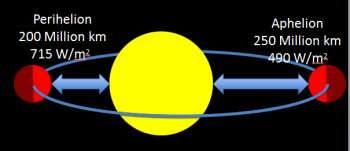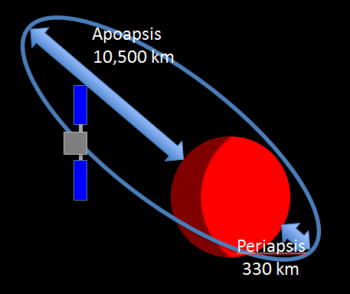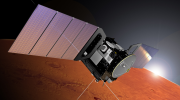Today’s post was contributed by Luke Lucas, a Mars Express spacecraft operations engineer at ESA’s ESOC mission control centre. Read to the bottom for more info and registration for the upcoming Open Data Day, 28 October 2016, at ESOC! Link to live webcast also at foot of this post.
The vacuum of space is a challenging thermal environment. The illuminated side of an object may reach more than 250°C while the non-illuminated side may be less than -150°C.
Without careful consideration such temperature differences could cause parts of the spacecraft to break, twist or fail to function.
For example: the temperature difference between the front and back of the arrays may be hundreds of degrees and when the arrays go from the shadow of an eclipse, sudden and dramatic changes in temperature occur, which can lead to expansion, contraction, torsion and twisting. Selection of correct materials and good structural design are essential.

Mars Express eclipse Credit: ESA
Maintaining an optimal thermal environment is the task of the craft’s thermal subsystem. The thermal subsystem includes electrical heaters where needed to keep the spacecraft warm (e.g. to prevent fuel lines from freezing) and passive radiators to keep other units cool. In this way Mars Express can perform scientific observations.
Cooling of some units to prevent overheating can be achieved by the clever siting of radiators. By placing radiators where they will always be facing deep space, passive cooling occurs.
The use of multi-layer insulating blankets around the spacecraft promotes a stable thermal environment and minimises the loss of heat to space.
Electrical heaters are used to heat Mars Express and maintain units, structures and instruments within their safe, warm operating range, with more than 200 thermistors continually measuring the temperature at various points around the spacecraft. By monitoring the measured temperatures, the heaters are turned on or off as needed.
As well as keeping MEX warm, it is important to know how much power is needed to achieve this. Power is supplied by either the solar arrays (when exposed to sunlight) by the batteries during an eclipse.
Power produced by either the solar arrays or batteries is used for platform operations, thermal operations and whatever remains is available for science. The energy provided by the batteries during an eclipse is finite, so knowing how much power is needed for the thermal subsystems means mission controllers can know how much power is available for science. Knowing accurately how much power is needed by the thermal subsystem means we can really maximise science observations.
So how much power does the thermal subsystem need to keep MEX warm?
Well it depends how cold the spacecraft is. And that, in turn, depends on many factors. The largest factors include:
-

Mars orbit Credit: ESA
How far away is MEX from the Sun? The Sun emits solar flux, measured in W/m2, (power per square meter received) and the further away from the Sun, the less flux received – and so the cooler is Mars Express
- What is the solar aspect angle? This is the angle of the spacecraft with respect to the Sun? Where is the Sun is shining on MEX? On the top (+Z face), the bottom (-Z face) or the +X face, and at what angle to that face? This will affect the craft’s temperature.
- How far is MEX from the surface of Mars? The albedo is the amount of energy reflected off the planet. ‘Mars shine’ refers to the amount of energy being reflected by the planet and can affect MEX’s thermal condition.
-

Mars Express orbit Credit: ESA
How far away is Mars from the Sun? This affects the Mars albedo, which in turn affects MEX.
- Is there an eclipse happening? As seen above, during eclipse, MEX is in Mars’ shadow, receiving no illumination from the Sun, and this can cause a dramatic cool down.
- What operations are on going? Certain operations, such as using the transmitter to communicate with Earth, warm up certain sections of the spacecraft.
Here are two thermally representative images of the -Y face, one seen during a communication pass and one when no communications were happening.
In a communication pass with temperatures up to 16°C

Mars Express -Y face, during a communication pass with a ground station Credit: ESA
When not communicating with Earth and temperatures as low as -12°C

Mars Express -Y face, not during a communication pass with a ground station Credit: ESA
That is to say, that the thermal power required changes continuously as the craft orbits Mars and as Mars orbits the Sun; no two days are the same. Predicting the thermal power required is a puzzle of many parts. But it is a very important matter, because we want to perform as much science as possible.
We have a model we use to predict the power required, but wondered if anyone could derive something better.
Our engineering approach is to look at the factors involved and create an equation. But it is always good to look at any puzzle from more than one view. So we asked you, the public to look at this, as the Mars Express Power Challenge.
And – Wow! – we were thrilled by the responses we received, the predictive models that were built and the amount of information shared among this wonderful community of data scientists, researchers, and space fans!
The challenge is now over and the winners will present their solution on 28 October 2016, at ESA’s ESOC mission control centre, Darmstadt, Germany. On this day, the Centre will host an ‘open data day’ for the candidates – and anyone interested is welcome to attend!
This will be an exciting, inspiring day, full of great ideas and exchanges!
A few tickets for the open data day are still available here via EventBrite.
Watch live 28 October, 10:00-12:00 and 14:00-16:30 CEST




Discussion: 2 comments
This is a very informative post. Thanks.
I am asking here because I am not a customer of twitter and others. What functionality did Mars Express preserve during recent reboot? How did it accomplish attitude control, for example?